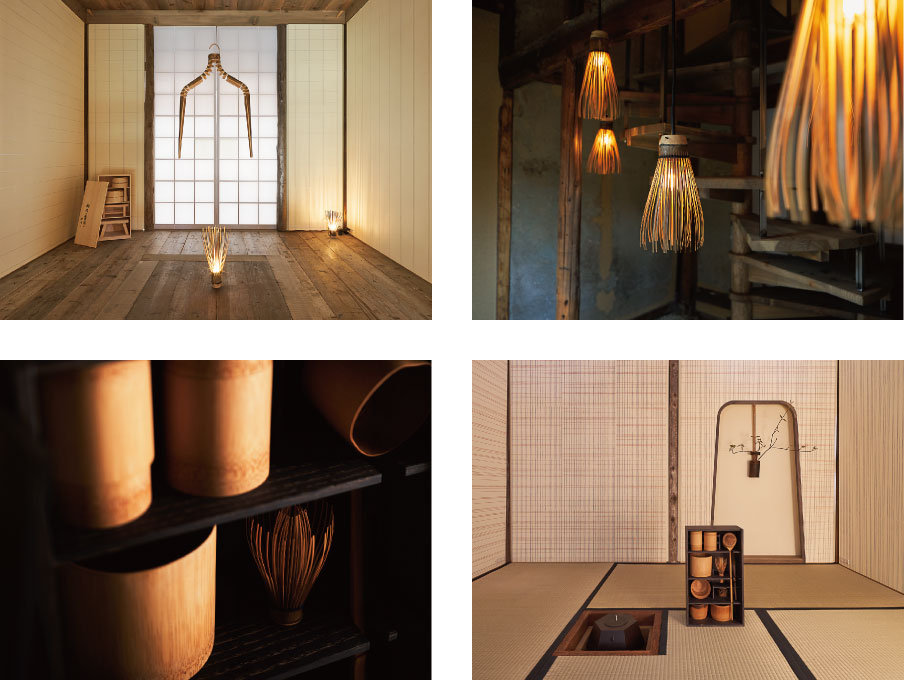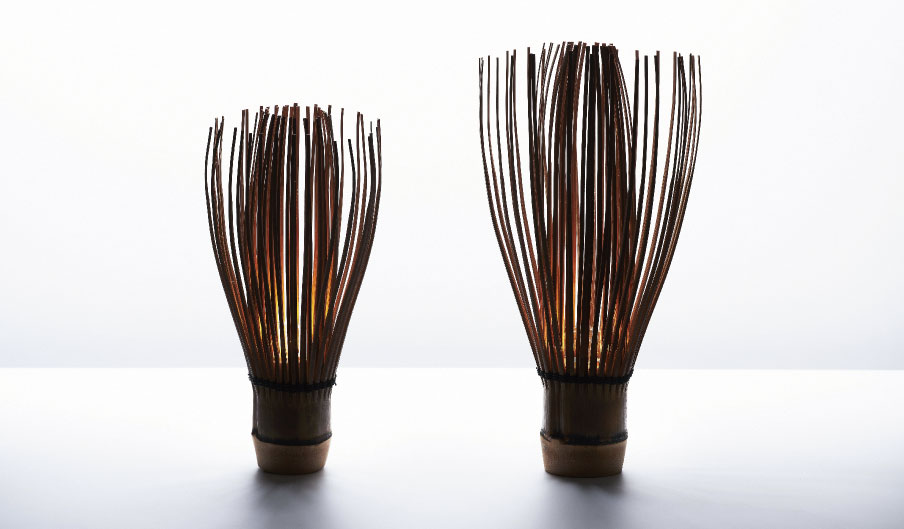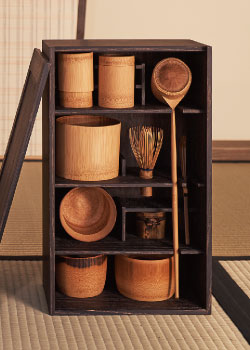

竹は、温暖で湿度の高い日本の風土に古くから根ざしました。本土に生育している竹の種類は、数100種とも言われています。なかでもよく利用されてきたものは、材質が薄くて緻密なマダケ(真竹)、厚くて柔らかいモウソウチク(孟宗竹)、細割りがきくハチク(淡竹)など。いずれも目をみはるほど成長が速く、かつ生命力がとても強いことが特徴です。わずか数ヶ月で立派な竹になります。
竹が育んだ日本文化の歴史を3つの側面から掘り下げてみます。1つめは、縁起物としての歴史です。平安時代に、中国から厳しい冬に友とすべき「歳寒三友」という松・竹・梅の画題の取り合わせが伝わると、日本人は時代を経て「松竹梅」に自分たちなりの解釈を加えます。平安時代に「松」を、室町時代に「竹」を、江戸時代に「梅」を、鶴亀とならぶ縁起物としてとらえるようになります。
2つめは、竹を素材とした日用品から工芸品の歴史です。日用品という意味では、縄文時代にまでさかのぼると言われていますが、いわゆる竹細工を美術工芸にまで高めたのは、茶の湯の流行です。室町時代に侘茶が盛んとなって,竹の形を生かした一重切花生や二重切花生のような日本らしい竹細工が発達しました。茶筅や茶杓などの名品が生まれたのもこの頃です。
3つめは、安土桃山時代以降、茶室や数寄屋造の建材として使われた歴史です。床柱、下地窓、天井、そして垣根などに登場する竹は、主人の趣向そのものを反映する重要な位置を占めています。
このように日本人は、神秘性、空洞性,割裂性,強弾性,そして皮の滑りまで竹の優れた特性を生かして、さまざまな工夫をしてきました。KAIでは、そうした竹の魅力を全面に引き出す一つの試みとして、茶道具一式を竹で作るという試みに取り組みました。
Bamboo has traditionally taken root in the warm and moist climate of Japan. The Japanese mainland is said to have around 100 varieties of bamboo. Among them, madake (Japanese timber bamboo), which is thin and dense, mosochiku (tortoise-shell bamboo), which is thick and soft, and hachiku (Henon bamboo), which can be split into thin strips, have commonly been used. All of these varieties are characterized by amazingly fast growth and very strong survival power. They grow into full-fledged bamboo plants in a few months.
We will delve into the history of Japanese culture nurtured by bamboo from three perspectives. First, we will examine the history of bamboo as lucky charms. When combinations of pine, bamboo and plum motifs were introduced as Saikan no Sanyu (The Three Friends of Winter) from China during the Heian period, the Japanese over time added their own interpretation of shochikubai (pine, bamboo and plum). “Pine” was popular as a lucky charm during the Heian period, while “bamboo” took on this mantle during the Muromachi period, and this was superseded by “plum” during the Edo period, together with the lucky charms crane and tortoise.
Second, is the history from daily necessities to craftworks made from bamboo. It is said that the use of bamboo in daily necessities dates back to the Jomon period, however, it was popularity of the chanoyu tea ceremony that elevated bamboo wares into the realm of arts and crafts. When the wabi-cha style of tea rose to prominence in the Muromachi period, Japanese style bamboo crafts with imaginatively shaped forms such as single-cut or double-cut flowers were developed. It was also around this time that tea whisks, tea ladles and other such items emerged.
Third, is the history of bamboo as a building material for use in tea houses and sukiya-style buildings from the Azuchi-Momoyama period onwards. The bamboo used in alcove posts, window lattices, ceilings and hedges was an important element in reflecting the owner’s preferences.
In this way, the Japanese have creatively utilized bamboo’s outstanding features, namely its mystery, hollowness, splitting qualities, tough elasticity and smoothness, in various crafts and structures. KAI has attempted to manufacture a set of tea implements from bamboo in effort to fully extract this appeal of bamboo.

茶事を行うときに必要な道具といえば、茶入れ・茶碗・茶杓などの点茶用具、掛け物・花入れなどの装飾用具、折敷・四つ碗などの懐石用具、水桶などの水屋用具、そして円座などの待合用具というように、大きく分けて5つほどがあります。今回、KAIはそのなかで、主に点茶用具と装飾用具に絞って「竹づくし」の品々を作りました。茶入れ、茶碗、茶杓、茶筅、柄杓、蓋置、そして花入れです。
使用した竹は、高知県の山奥に群生しているモウソウチク。竹から材を切り出す前に、1週間ほど朝から晩まで火を焚いて竹を燻しました。職人の下本一歩さんは、独特の艶と濃淡がついた「燻し竹」を眺めながら、どの部分でどのお道具を作るかを見極めます。どのお道具も材を繋ぐことはせずに、竹を割ったときにできる竹そのものの形をいかしました。
「竹の茶道具一式」のなかで下本さんの遊び心がもっとも突出しているものは茶碗です。ポテッとした大ぶりのものと慎ましやかに小ぶりなもの、飲み口を真っ直ぐ立ち上げたものと内側に優しく削りこんだもの、燻した表面をあえてすべて削ったものと形を際立たせるために部分的に削ったものなど。1つ1つが2つとない表情となっています。ふわっとした口触りと軽やかな持ち触り、そしてほどよい燻香が立ち上がる竹の茶碗です。
KAI-CHIKU制作:下本一歩
The implements required for conducting a tea ceremony are broadly divided into five groups: namely, items for preparing tea, such as tea bowls, tea whisk and tea ladle; decorations, such as a hanging scroll and vase; kaiseki (meal eaten before tea is served) implements such as lacquered wooden tray and set of four bowls; kitchen implements such as water pail; and waiting implements such as round mats. Among those, KAI has here selected mainly the items for preparing tea and the decorations to make “wares using only bamboo”, namely the tea bowls, tea whisk, tea ladle, waste-water container, lid rest and vase.
Mosochiku (tortoise-shell bamboo) that grows deep in the mountains of Kochi Prefecture was used. Before cutting the parts from the bamboo, the bamboo was smoked by lighting a fire from morning to evening for around one week. The artisan Mr. Kazuho Shimomoto decided which parts to use in each implement while viewing the “smoked bamboo” with its distinct luster and intensity. In all the implements, he utilized the shapes formed when splitting the bamboo, without fastening the pieces.
Among the “set of bamboo tea implements,” Mr. Shimomoto’s spirit of playfulness is most clearly manifested in the tea bowls. Each bowl has its own unique expression, ranging from large, plump bowls to small, modest bowls, from those having a straight rim to those with a rim that curves gently inwards, from those with the smoked surface entirely planed away to those where it is only partially planed so as to accentuate the shape, and so on. These are the bamboo tea bowls that give a pleasing smoked aroma and has a soft palate with light weight and nice touch.
KAI-CHIKU: Made by Kazuho Shimomoto

茶道具一式のほかに、かつて下本さんと相談しながらつくった竹の照明「茶筅ライト」も展示します。その名のとおり茶筅の形を模したデザインです。天井から吊るすとシャンデリアになり、床置きすると行燈になります。灯体は、茶筅の節から穂先にむかう一本一本の上り穂(外穂)にかこまれていて、そこから洩れ広がる明かりは線状のリズミカルな影をつくります。また、この照明はたった1つでも十分な存在感がある一方、次から次へと並んでいてもまったく威圧感がなく、竹藪のような美しさがあります。
KAIは、今後も竹という素材に注目していきます。竹は、鑑賞面でも実用面でも、世界に通用する圧倒的な魅力があります。1882年、エジソンは日本のマダケのヒゴを炭化してフィラメントとして白熱電灯をつくりました。まだ見つけていない竹の可能性を、KAIらしいやり方で見つけていきたいです。
In addition to tea implements, “tea whisk lights” (lighting fixtures), which we previously manufactured in consultation with Mr. Shimomoto, will be put on display. As the name suggests, these lights are literally designed in the shape of tea whisks. They can be hung from the ceiling as chandeliers, or placed on the ground as lamps with paper shades. The light element is surrounded by strands branching upwards from the tea whisk node, and the light that filters out through them creates rhythmical linear shadows. Even a single such light has ample presence, however, when they are lined up, they are not intimidating but rather aesthetically pleasing like a bamboo grove.
KAI will continue to focus on bamboo as a material even moving into the future. Bamboo has overwhelming worldwide appeal both in the aesthetic and the practical senses. In 1882, Edison made an incandescent lamp with a filament made from a carbonized Japanese timber bamboo splinter. At KAI, we aim to uncover the undiscovered possibilities of bamboo in our own unique style.
Speaker: Shiro Miura Interviewer: Kanako Izumi
語り手 : 三浦史朗 書き手 : 和泉佳奈子



| 竹茶道具一式 | Set of bamboo tea implements |
|---|---|
| 箱サイズ:h455×w275×d155mm | Box size:h455×w275×d155mm |
| 道具箱:栗、黒染め仕上げ | Specifications:Sawara cypress |
| 竹茶道具:モウソウチク | Bamboo tea implements:Mosochiku (tortoise-shell bamboo) |
| ・茶碗×3 | ・Tea bowls ×3 |
| ・茶入×2 | ・Tea containers ×2 |
| ・茶筅 | ・Tea whisk |
| ・茶杓 | ・Tea ladle |
| ・柄杓 | ・Dipper |
| ・建水 | ・Wastewater container |
| ・蓋置 | ・Lid rest |

| 竹照明 | Bamboo lights |
|---|---|
| 仕様:モウソウチク | Specifications: Mosochiku (tortoise-shell bamboo) |
| ・ペンダント | ・Pendant |
| ・スタンド (参考品) | ・Stand (Reference item) |
| ・デスク | ・Desk |
